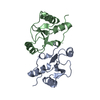+Search query
-Structure paper
| Title | An atypical BRCT-BRCT interaction with the XRCC1 scaffold protein compacts human DNA Ligase IIIα within a flexible DNA repair complex. |
|---|---|
| Journal, issue, pages | Nucleic Acids Res, Vol. 49, Issue 1, Page 306-321, Year 2021 |
| Publish date | Jan 11, 2021 |
 Authors Authors | Michal Hammel / Ishtiaque Rashid / Aleksandr Sverzhinsky / Yasin Pourfarjam / Miaw-Sheue Tsai / Tom Ellenberger / John M Pascal / In-Kwon Kim / John A Tainer / Alan E Tomkinson /   |
| PubMed Abstract | The XRCC1-DNA ligase IIIα complex (XL) is critical for DNA single-strand break repair, a key target for PARP inhibitors in cancer cells deficient in homologous recombination. Here, we combined ...The XRCC1-DNA ligase IIIα complex (XL) is critical for DNA single-strand break repair, a key target for PARP inhibitors in cancer cells deficient in homologous recombination. Here, we combined biophysical approaches to gain insights into the shape and conformational flexibility of the XL as well as XRCC1 and DNA ligase IIIα (LigIIIα) alone. Structurally-guided mutational analyses based on the crystal structure of the human BRCT-BRCT heterodimer identified the network of salt bridges that together with the N-terminal extension of the XRCC1 C-terminal BRCT domain constitute the XL molecular interface. Coupling size exclusion chromatography with small angle X-ray scattering and multiangle light scattering (SEC-SAXS-MALS), we determined that the XL is more compact than either XRCC1 or LigIIIα, both of which form transient homodimers and are highly disordered. The reduced disorder and flexibility allowed us to build models of XL particles visualized by negative stain electron microscopy that predict close spatial organization between the LigIIIα catalytic core and both BRCT domains of XRCC1. Together our results identify an atypical BRCT-BRCT interaction as the stable nucleating core of the XL that links the flexible nick sensing and catalytic domains of LigIIIα to other protein partners of the flexible XRCC1 scaffold. |
 External links External links |  Nucleic Acids Res / Nucleic Acids Res /  PubMed:33330937 / PubMed:33330937 /  PubMed Central PubMed Central |
| Methods | EM (single particle) / X-ray diffraction |
| Resolution | 2.4 - 31.5 Å |
| Structure data |  EMDB-22130:  EMDB-22307:  PDB-6wh1:  PDB-6wh2: |
| Chemicals |  ChemComp-HOH: |
| Source |
|
 Keywords Keywords | DNA BINDING PROTEIN/LIGASE / DNA ligase complex / DNA repair / DNA BINDING PROTEIN / DNA BINDING PROTEIN-LIGASE complex |
 Movie
Movie Controller
Controller Structure viewers
Structure viewers About Yorodumi Papers
About Yorodumi Papers



 homo sapiens (human)
homo sapiens (human)